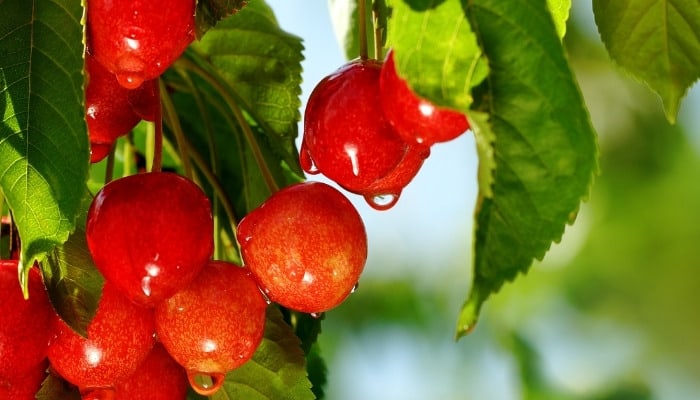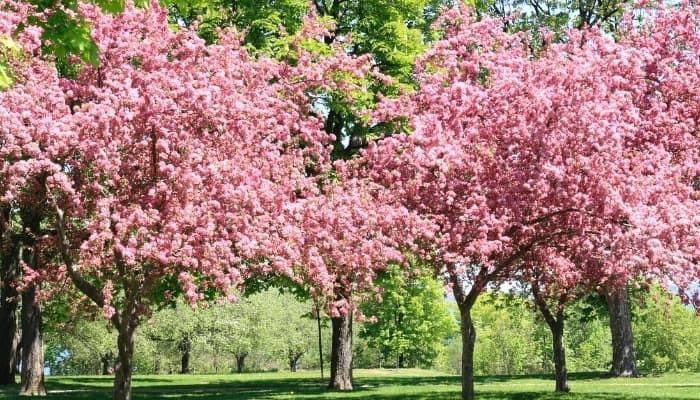Are you considering planting cherry trees but unsure of the appropriate height for your yard, garden, or farm?
With so many types of cherry trees, there are a lot of choices. But, don’t worry, we’re going to walk you through the process.
How tall are cherry trees? The height of cherry trees ranges from 6 feet to over 100 feet. Standard cherry trees reach heights of 12 to 20 feet, while larger species grow up to 50-plus feet tall. Furthermore, dwarf trees in containers grow between 6 feet and 10 feet tall, and wild cherry trees reach 130-plus feet tall.
Read on below and explore cherry tree heights and everything you need to know about selecting and caring for a cherry tree!
Cherry Tree Size
Choosing the right cherry tree size for your property is crucial, whether it’s a yard, garden, orchard, or farm.
There is an enormous difference between a 100-foot tall cherry tree and a 15-foot tall tree. This quick guide lays out the differences in height in all of the most popular varieties and species.
Ornamental Cherry Tree Size
The average size of ornamental cherry trees is between 20 and 30 feet. They do well in just about any soil and sun conditions as long as the soil drains well and stays moist.
Ornamental cherry trees are preferred for landscaping because they are low maintenance, look great, and live for up to 50 years.
Edible Cherry Tree Size
Sweet cherry trees, or “edible” cherry trees, reach sizes of 15 to 25 feet on average. However, under the right conditions, they may grow as much as 10 or 15 feet taller.
Dwarf species are also available and reach max heights and widths of 10 to 15 feet.
Wild Cherry Tree Size
A fan favorite, wild cherry trees are actually among the tallest, with an average height variance of 50 to 80 feet.
That said, the tallest wild cherry trees are over 130 feet tall and have a spread between 50 and 70 feet wide.
Dwarf Cherry Tree Size
The term “dwarf cherry tree” is more of an umbrella phrase than an actual species; it refers to miniature cherry trees of any species.
Most dwarf cherry trees are engineered to grow no taller than 12 to 15 feet with an equal spread width.
But, there are even much smaller dwarf cherry trees. The Hiromi weeping cherry tree, for example, is a Japanese dwarf tree that only reaches heights of up to 6 feet tall.

Factors That Affect Cherry Tree Mature Size
There are several significant factors to take into consideration when it comes to the size of your mature cherry trees:
- No less than 8 hours of sun per day is best for optimal growth.
- Trees need watering several times per month after planting.
- Trees require extra watering through the year while they are young.
- Trees require regular pruning to stimulate vigorous growth.
- Fruit trees in particular benefit from receiving fertilizer/nutrients.
- The pH of the soil affects the health and growth of the tree.
- The roots may need irrigation depending on the environment.
- Producing too much fruit slows down the overall growth of the tree.
Sizes of Popular Cherry Tree Varieties
There are dozens of cherry tree varieties. The 10 species below are the most popular.
Guide To Selecting a Cherry Tree
The first step to selecting a cherry tree for your yard, garden, or farm is deciding whether you want cherries for cooking or for eating. One type of cherries is acidic, and the other is sweet and edible raw.
After you decide which type you want, have a look at the available rootstock. Keep in mind that each species has its own maximum height and width, as pointed out throughout this article.
Also consider the particular sun, water, and pH requirements of any cherry tree species you’re considering planting on your property.
Make sure that you have the right sort of environment to promote healthy growth.
Another consideration is that some species, mainly the dwarfs, may be grown in pots if you prefer.
That way you can move them around throughout the year and even take them inside for the winter.
Be sure that you only purchase cherry trees from a reputable, trusted supplier. Check with our list of online sources if you can’t find quality cherry trees locally.
Cherry Tree Basic Care
Caring for cherry trees is pretty basic. In fact, as far as fruit trees are concerned, cherry trees are one of the lowest-maintenance groups of trees there is.
Following these basic care guidelines and your tree will thrive:
- Water new trees 2-3 times per week.
- Water young trees every other week during the spring, summer, and fall.
- Water older trees in the spring and fall.
- Apply fertilizer/nutrients to trees once per year.
- Prune branches so the sun penetrates more of the tree.
- Make sure your trees receive 6 to 10 hours of direct light.
- Use organic pest control.
- Keep birds away from your ripening cherries.
Related Questions:
How Fast Do Cherry Trees Grow?
Depending on the species, a cherry tree may grow anywhere from 8 to 15 inches or more per year.
In less optimal environments, cherry trees may grow as little as 5 to 6 inches or less per year.
How Long Do Cherry Trees Live?
Cherry trees don’t have the longest lifespan; they live approximately 20 to 30 years or so. Some species die after 15 years, and others live to well over 50 years.
That said, there are numerous examples of black cherry trees that are between 250 and 2,000 years old and are still living and flowering.
Conclusion
The average minimum height of cherry trees is between 10 to 20 feet with some species reaching minimums of 40 to 50 feet.
The average maximum height is roughly 30 to 50 feet, though some trees easily reach over 100 feet tall.
The biggest factors that influence the height of a cherry tree, other than its species, include the pH of its soil, the amount of sun it receives, how well watered it is, and whether pests are infesting it or not.

